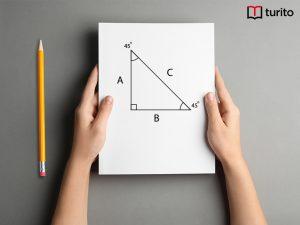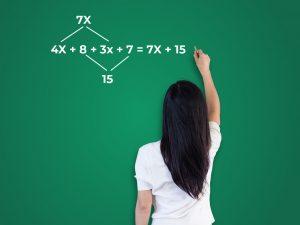Magnification by Spherical Lenses
 Introduction
Introduction
The lenses form various kinds of images such as magnified, diminished, same sized, real, virtual, inverted and upright. An image formed by a lens has a combination of some of these properties. The size of the image w.r.t the object can be measured via the concept of magnification. In this section we will be looking at the magnification produced by a lens.
 Explanation
Explanation
Magnification:
Magnification is a measure of how large or small in size the image of an object is, compared to that of the object.
The magnification ‘m’ is mathematically given by,

In the above formula, the height of the object is taken to be positive, as the object is usually placed above the principal axis.
The height of the image is taken to be negative for a real image and positive for a virtual image.
The magnification is a unitless physical quantity.
Magnification is also related to the object distance (u) and the image distance (v) as follows.

Case 1: For a magnified image:
For a magnified image, the size of the image is greater than the size of the object.
That is H > h. Therefore,

gives, m >1.

Case 2: For a diminished image:
For a diminished image, the size of the image is smaller than the size of the object.
That is H < h. Therefore,

gives, m <1.

Case 3: For a same sized image:
For an image of the same size as the object,
H = h. Therefore,

gives, m = 1.

Magnification is also related to the object distance (u) and the image distance (v) as follows.

- A negative value of magnification indicates a real and inverted image.
- A positive value of magnification indicates a virtual and upright image.
Questions and Solutions:
- A pole of height 4 m is placed at a distance of 60 cm in front of a convex lens of focal length 30 cm. How magnified or diminished will the image of the pole produced by the lens be? What is the nature of the image formed?
Solution:
The height of the pole = 4 m
Object distance = 60 cm
Focal length = 30 cm.
The radius of curvature = 30 x 2 = 60 cm
Therefore, the object is located at the radius of curvature of the lens.
Thus, a real, inverted and same sized image is formed at the center of curvature on the other side of the lens.
Therefore, the height of the image of the pole = – 4 m.

Therefore, magnification is – 1. The negative sign indicates the real and inverted nature of the image.
Thus, the image of the pole is formed at a distance of 60 cm on the other side of the lens and is real, inverted and of same size as the pole itself.
- An object, 2 m tall is placed perpendicularly to the principal axis of a convex lens of focal length 50 cm. The distance of the object from the lens is 75 cm. Find the nature, position and size of the image and its magnification.
Solution:
Given that,
The type of lens = convex lens
Focal length (f) = 50 cm
Object distance (u) = – 75 cm
Size of the object (h) = 2 m
Image distance (v) = ?
Position of the image = ?
The lens formula is given by,

It means that the image is twice the size of the object, and the negative sign indicates that the image is real and inverted.
Therefore, the height of the object = 2 m.

Therefore, the height of the image = – 4 m.
Summary
- Magnification is a measure of how large or small in size the image of an object is,
compared to that of the object. - The magnification ‘m’ is mathematically given by,
m= height of the image / height of the object = = v / u
= v / u - The value of magnification is given as under.
a. m > 1, when the image is larger than the object,
b. m <1, when the image is smaller than the object, and
C. m = 1, when the image is of same size of the object. - Positive magnification indicates a virtual and upright image, and a negative
magnification indicates a real and inverted image.
Related topics
Different Types of Waves and Their Examples
Introduction: We can’t directly observe many waves like light waves and sound waves. The mechanical waves on a rope, waves on the surface of the water, and a slinky are visible to us. So, these mechanical waves can serve as a model to understand the wave phenomenon. Explanation: Types of Waves: Fig:1 Types of waves […]
Read More >>Dispersion of Light and the Formation of Rainbow
Introduction: Visible Light: Visible light from the Sun comes to Earth as white light traveling through space in the form of waves. Visible light contains a mixture of wavelengths that the human eye can detect. Visible light has wavelengths between 0.7 and 0.4 millionths of a meter. The different colors you see are electromagnetic waves […]
Read More >>Force: Balanced and Unbalanced Forces
Introduction: In a tug of war, the one applying more force wins the game. In this session, we will calculate this force that makes one team win and one team lose. We will learn about it in terms of balanced force and unbalanced force. Explanation: Force Force is an external effort that may move a […]
Read More >>Magnets: Uses, Materials, and Their Interactions
Introduction: Nowadays magnets are widely used for many applications. In this session, we will discuss the basics of magnets and their properties, and the way they were and are used. Explanation: Magnets: Magnetic and Non-magnetic Materials: Poles of a Magnet: Fig No. 1.2: Poles of a magnet Compass: Interaction Between Magnets: The north pole of […]
Read More >>Other topics







Comments: